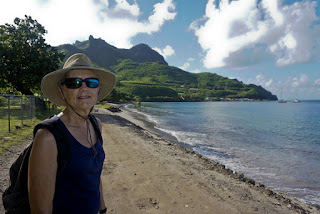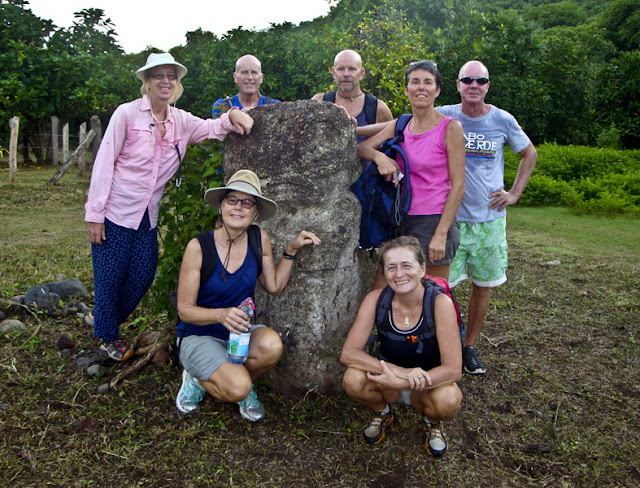One of the challenges of living on a sailboat is getting exercise. Sure, the boat is continually moving so you get a fair amount of isometric exercise by just stumbling around, but the key is aerobic exercise. We’re not very good at this.
We have friends who go on marathon hikes all the time, but it seems more difficult for us. I don’t know if it’s the heat, the hassle, or our age. Usually it’s because we’ve become involved in some mammoth project on the boat and are just too wiped out. But we are making an effort.
With sketchy directions from friends we set out on a hike to Matauapuana lookout, a huge rock monolith at the head of the bay. There are two of them, one on each side of the bay, and the locals call them The Sentinels, because in the old days lookouts would be posted to warn of war parties or sailing ships coming towards the harbor.
With our trusty Pocket Earth app on our iPhone we tried to reconcile the sketchy directions with the trails on the map. We went through a yellow locked gate and began climbing the hill right behind town on a washed out road. Was an interesting trail that someone had recently cleared but as we got higher and higher it finally petered out to 10 ft. high brush where the trail should be. We met a young French girl and her Tahitian boyfriend who had been following us “because you looked like you knew where you were going.” Boy, we fooled them.
 |
| I imagine this dog saying "Dude, I've done this hike a hundred times. Just trust me." |
 |
| Our goal is about one-half way up the ridge line for the Sentinels that overlook the ocean. |
 |
| The views of the harbor along the right side of the trail were breath-taking. |
Back down to the road, we went with Plan B which was to simply walk in the direction of the Sentinels. We eventually meandered our way there through an industrial area on the outskirts of the village. Once we got on the trail it was beautiful hiking with spectacular views on our left side of the bay and exotic jungle-like terrain with low overhanging trees. As usual we had picked up one of the village dogs as our hiking companion. They always seem to make it about half way on the trail and then turn back. Wimps.
 |
| There are two "Sentinels" guarding the bar, this is the west most Sentinel. |
On the way back we could follow other hikers and see exactly where the trail from town (which we were supposed to have been on) was located. We ended up doing this hike once again later in the week and it was much easier now that we knew the trail.
 |
| Nothing like a cold drink after an arduous hike along the waterfront road. |
We also started exploring the areas around the village, many pioneered by our friends Roger and Sasha on Ednbal. The simplest walk is all the way around the harbor to the other side, walking on the main road the whole way. Since this goes right along the shoreline it’s a beautiful hike and at the end is the Pearl Lodge with its infinity pool and spectacular views of the harbor. The price of the drinks will induce arrhythmia but it is a picturesque setting.
 |
| Just walking to the grocery stores along the waterfront road is beautiful. |
 |
| If you watched Survivor: Marquesas you'll recognize this beach from the tribal council sessions. |
 |
| Back row from L to R: Katie (Mezzaluna), Roger (Ednbal), Jeff (Mezzaluna), Amanda and Mark (Balvenie). Front row: Meryl (Flying Cloud) and Sasha (Ednbal). |
One day we all got up at 4:30 am for a 5:30 am departure from the Pearl Lodge to Collette Bay, the location where they filmed the tribal council meetings for Survivor: Marquesas. We went with the crews of Ednbal, Balvenie, and Mezzaluna. It was fun to hike with various people and chat along the walk as the hike was somewhat easy with a quick jaunt up the ridge then a long walk down to the bay. We tried to find remnants of the filming of Survivor but nothing was evident. A nice hike with nice friends.
Our goal is to get out everyday for a walk somewhere, but when we get involved in boat projects it seems were are too wiped out by the heat to leave the boat. Then we just jump in the water to cool off and swim a few laps around the boat and call it a day. I figure that trying to out swim a shark back to the boat beats trying to out run two foaming-at-the-mouth pit bulls.
As I said, our hiking program is a work in progress.



























